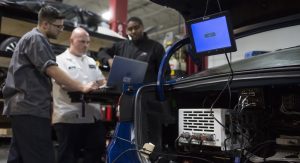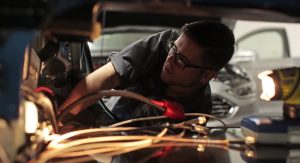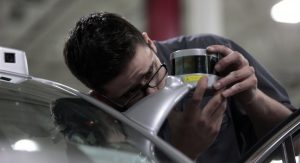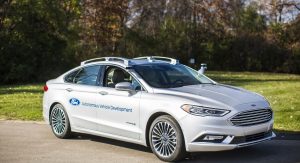Ford is launching their next-generation Fusion Hybrid autonomous development car just in time for next year’s Consumer Electronics Show as well as the Detroit Auto Show in January.
While the new model uses Ford’s current autonomous vehicle platform that made its debut three years ago, it packs more processing power thanks to the upgraded computer hardware.
Furthermore, its electrical controls are closer to being ready for production, while adjustments made by Ford to the Fusion’s sensor technology (including placement), allow the car to better see it’s surroundings. The new LiDAR sensors now come with a different design, featuring a more targeted field of vision, which in turn enables the car to get the same amount of data using just two sensors instead of four.
What makes this new-generation autonomous development vehicle truly special, according to Ford, is the fact that it will make a big leap in terms of its virtual driver system, where the goal is to have a fully autonomous SAE-defined level 4-capable vehicle that doesn’t need a driver.
In order to do that, this Fusion Hybrid test car features LiDAR, cameras and radar, but also new algorithms for localization and path planning, computer vision and machine learning, highly detailed 3D maps and more computational and electronics power.
“The Virtual Driver’s responsibilities can be slotted into three tasks: sensing the surrounding environment, using that perception to make decisions on the road, and controlling the car”, chief program engineer Chris Brewer explained. “The Fusion Hybrid’s autonomous brain is located in the trunk, where the equivalent of several high-end computers generate 1 terabyte of data an hour – more than the average person would use in mobile phone data in 45 years.”
In the end, the new-gen autonomous development vehicle is meant to bring Ford a step closer to offering a fully autonomous car by the year 2021 for ride-sharing and ride-hailing services. “For now, the car still comes with a steering wheel and pedals – equipment our ride-sharing vehicles ultimately won’t include”, said Brewer.



![Ford Debuts Next-Gen Fusion Autonomous Test Vehicle [w/Video]](https://www.carscoops.com/wp-content/uploads/2016/12/ford-nextgen-fusion-autonomous-car-7.jpg)





